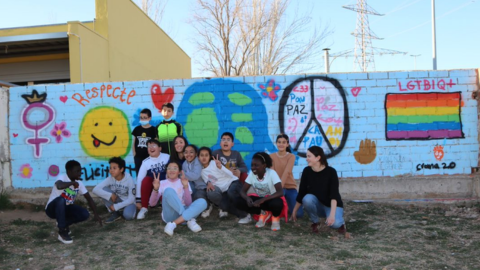Research project on cultural and linguistic diversity run from CROMA 2.0 workshops

The MIRAS research group has set up the “Together we learn our worlds” project at four schools close to the UAB as part of the workshops on the CROMA 2.0 socio-educational programme. Work has been done on cultural and linguistic diversity, showcasing the heritage and families of the participating children.
28/04/2023
“Together we learn our worlds” is a project (financed by the European Union's Horizon 2020 programme, ref. no. 101004640), involving the MIRAS (Mediation and Interpretation: Research in the Social Environment) group from the Faculty of Translation and Interpreting at the Universitat Autònoma de Barcelona and which is held in the workshops of the CROMA 2.0 socio-educational programme run by the Fundació Autònoma Solidària.. From the UAB, the project has been carried out for the first time at four schools in Vallès Occidental: Escola Sant Martí in Cerdanyola, Escola Les Fontetes in Cerdanyola, Institut-Escola Antoni Ubach in Terrassa and Escola Joan Marquès i Casals in Terrassa.
As one of the project researchers, Mireia Vargas, explains in a video published by the FAS: “the research project is led by the University of Bologna but several universities from different countries in Europe are involved.” The activity is based on the “Together we learn our worlds” activity that is being run in Poland as part of the project titled New ABC H2020. The aim is to work on historical, linguistic and cultural heritage and help make children and families more aware of the linguistic and cultural diversity at their schools and in the neighbourhoods they live in. In line with the core ideas of the New ABC project, the proposal is structured around the principles of co-creation and research-action-participation, in which the children are responsible for deciding what they want to create and investigate.
Leonor Morral, a psychology student at the UAB and with a scholarship for the programme, explains how the project is being run in the workshops: “This project consists of nine sessions and the two coolest activities that people liked best were, first, a trip around the neighbourhood, where small groups went around collecting different information about the linguistic environment, posters in different languages, they interviewed people, to learn a little about the neighbourhood on those levels. And, second, artistic creation, which was graffiti.”
So, the children have gone on outings around the school to learn first-hand what languages are spoken in the local area. Everything they saw and learned on these outings was used to create the final product, which contains information about 4-8 points of interest, such as images, audio and/or video, sound recordings and other sensorially evocative elements. This product was presented in public to the families of the participant schools and will soon be available as open access.
At Escola Joan Marquès i Casals in Terrassa, one of the schools where graffiti was done, the children portrayed different elements linked to diversity. The students who were accompanied by the artist Blanca, from the organisation Kids&Cat, presented and explained the outcome and their experiences with the project in the following video.
This socio-educational program is supported by the Department of Equality and Feminism of the Government of Catalonia, the Barcelona Provincial Council, and the County Council of Vallès Occidental.